In 2023, 219,434 tonnes of municipal waste were generated, 4.3% less than in 2022
The state law on waste and contaminated soils for a circular economy sets a target of 13% reduction of waste generated by 2025 (compared to 2010), currently this reduction stands at 15.7% in the Maresme region
Data indicates that the current selective collection systems have reached their maximum efficiency
This week the Catalan Waste Agency has released the figures for municipal waste management for 2023.
In the Maresme, 219,434 tonnes of municipal waste were generated in 2023, 4.3% less than in 2022. The per capita generation was 492 kg/inhabitant/year, i.e. 27.7 kg/inhabitant/year less than last year.
This reduction in the tonnes of waste generated is in line with the objective of the Maresme Waste Prevention Plan, which began to be applied in 2022 using various strategies and which aims to reduce waste generation in the county by 26.4% by 2027, compared to 2010.
The Maresme is therefore playing its part and is exceeding the goal set by the state law on waste and contaminated soils for a circular economy, which has a target of 13% reduction of waste generated by 2025 (compared to 2010). This reduction currently stands at 15.7% in the Maresme region.
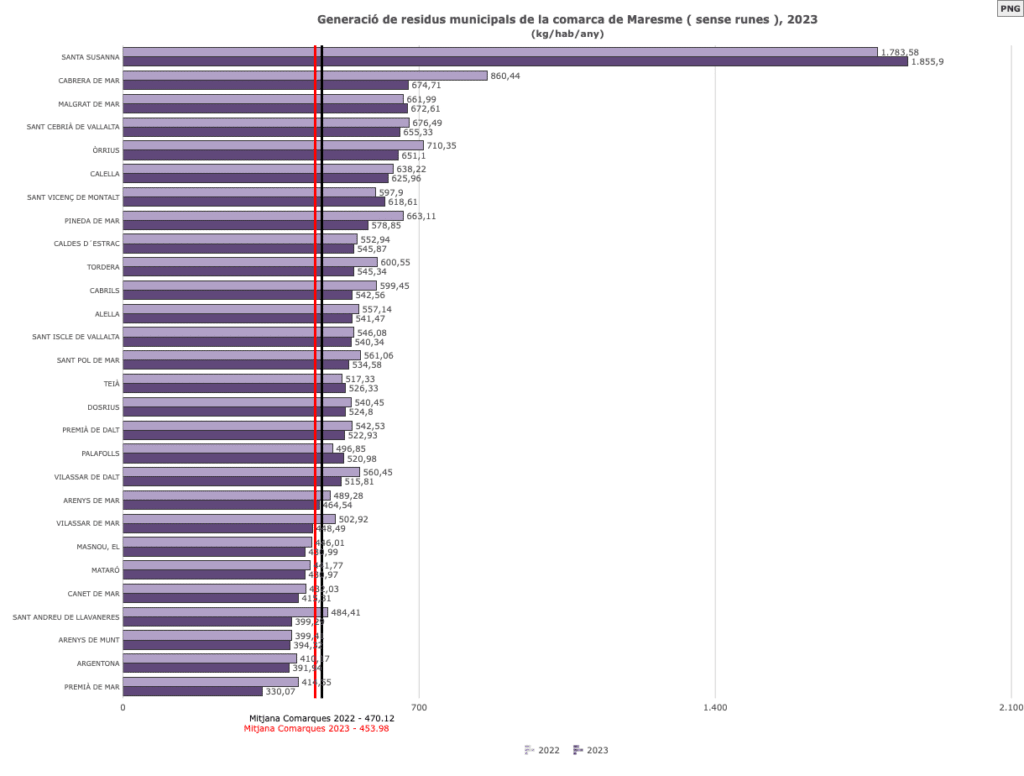
Municipal waste generation in the Maresme in 2023 / ARC
The effectiveness of efficient systems
Of the total municipal waste in the Maresme, 46.4% was collected selectively last year, specifically 101,800 tonnes, which represents 3.5% less than in 2022; a slight drop that shows a certain stagnation in the rate of selective collection.
“The current selective collection systems have reached maximum efficiency, and what is needed is to move towards efficient selective collection systems (door-to-door or closed containers with user identification),” emphasises the director of Maresme Circular, Carles Salesa.
A clear example of this is Sant Andreu de Llavaneres, which in 2022 implemented door-to-door collection, going from selectively collecting 58.8% of waste in 2022 to 79.6% in 2023, i.e. its percentage of selective collection has increased by almost 21 points since applying this efficient system.
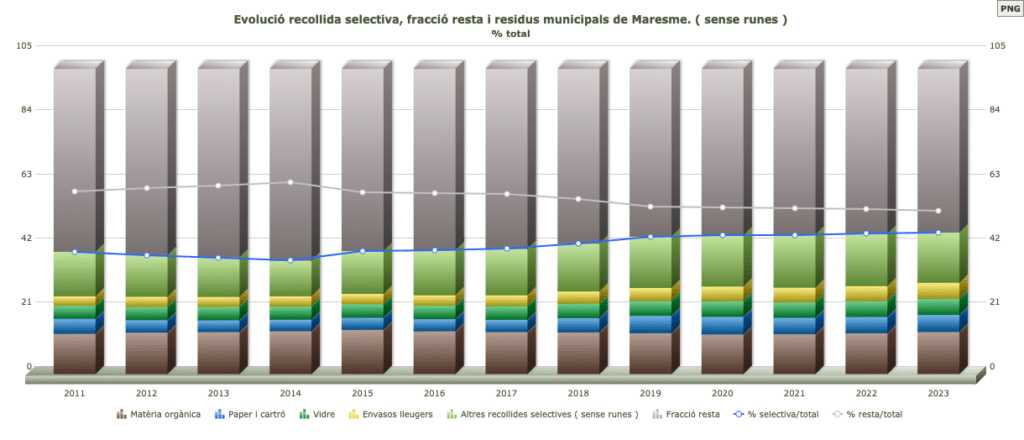
Evolution of selective waste collection in Maresme / ARC
Selective collection, municipality by municipality
According to statistics from the Catalan Waste Agency, fifteen of the twenty-eight municipalities in the county exceeded 50% selective collection in 2023: Argentona (86.0%), Sant Andreu de Llavaneres (79.6%), Arenys de Munt (79.4%), Teià (63.9%), Canet de Mar (63.1%), Sant Pol de Mar (58.7%), Sant Vicenç de Montalt (57, 6%), Cabrera de Mar (57.2%), Alella (56.2%), Dosrius (54.2%), Tordera (53.5%), Arenys de Mar (53.3%), Premià de Dalt (53.1%), Cabrils (51.0%) and Òrrius (50.6%).
Nine municipalities exceeded 40%, some of them almost 50%: Sant Cebrià de Vallalta (49.2%), Vilassar de Dalt (48.7%), Vilassar de Mar (48.1%), Caldes d’Estrac (47.9%), Palafolls (46.9%), Calella (43.2%), Premià de Mar (43.0%), El Masnou (43.0%) and Malgrat de Mar (41.9%).
Finally, only four municipalities did not reach 40% selective collection: Mataró (36.8%), Sant Iscle de Vallalta (36.8%), Pineda de Mar (33.5%) and Santa Susanna (26.9%).
Mataró increases selective collection by 3.1%
The data for Mataró shows that the selective collection trend in large cities, those with more than 50,000 inhabitants, continues.
Although the Catalan average for these large cities is 38.9% selective collection and Mataró is slightly below that figure (36.8%), in 2023 the capital of the Maresme increased the amount of waste collected selectively by 3.1% compared to 2022. This represents an increase of almost 2 percentage points in its selective collection rate, after implementing efficient systems such as Mobile Selective Collection in the Centre, mixed Door-to-Door in the Vista Alegre neighbourhood and Door-to-Door in housing developments outside the urban area (Vallveric, Can Quirze, La Forneca, Can Marqués, La Cornisa, Can Serra, Les Alcornoques and Vilardell).
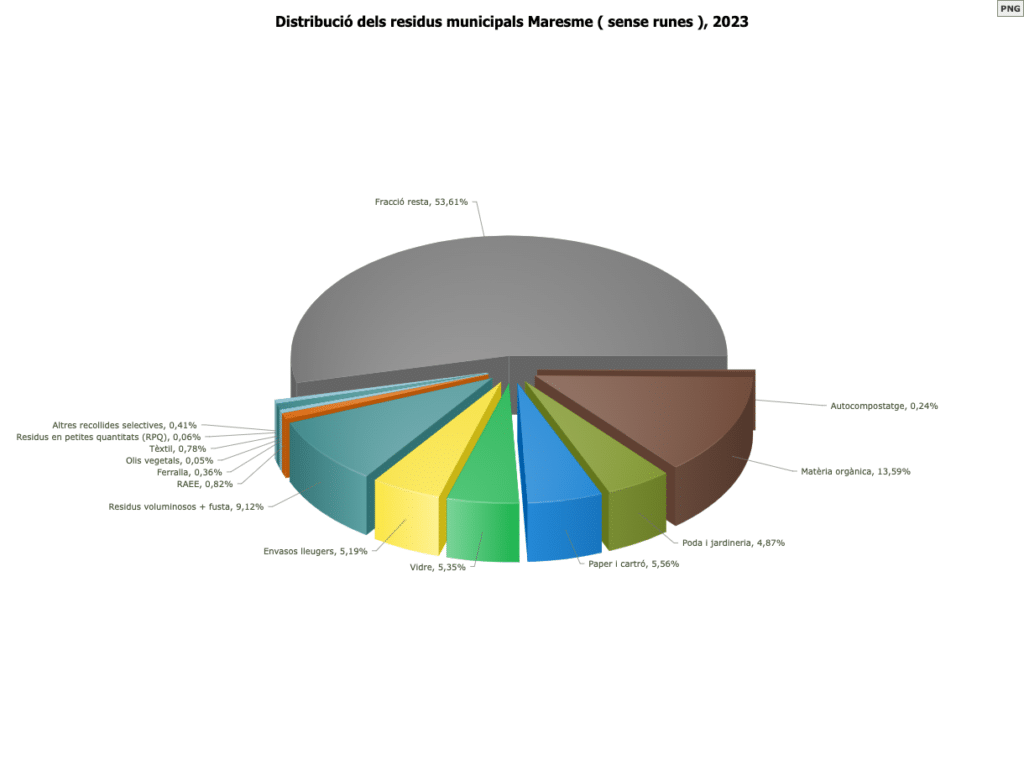
Distribution of municipal waste by fractions in the Maresme in 2023 / ARC
Selective collection, by fractions
Of the four main fractions of selective collection in Maresme, light packaging is the only fraction to increase, by 1.8%, while the other fractions show reductions: 1.6% for glass, 0.5% for paper/cardboard and 1.2% for the organic fraction. At the same time, self-composting in the Maresme region increased by almost 3%.
The fraction that recorded the greatest improvement was vegetable oils, which increased its selective collection in the county by 32.5%, followed by textiles, which grew by 3.4%.
The residual fraction continues to fall but represents more than half of the waste managed
The residual fraction (mixed waste collected in the grey bin), accounted for 53.6% of the total municipal waste generated in the Maresme, i.e. 117,633 tonnes. Despite the fact that the residual fraction is on a downward trend (this fraction has decreased by 4.9% compared to 2022), the figures show that still just over half of the municipal waste in the county is not separated at source in households and businesses.
In 2035, in accordance with European directives, only a maximum of 10% of the municipal waste generated can be taken to a controlled landfill for final treatment. This percentage currently stands at 0.1% in the Maresme region.
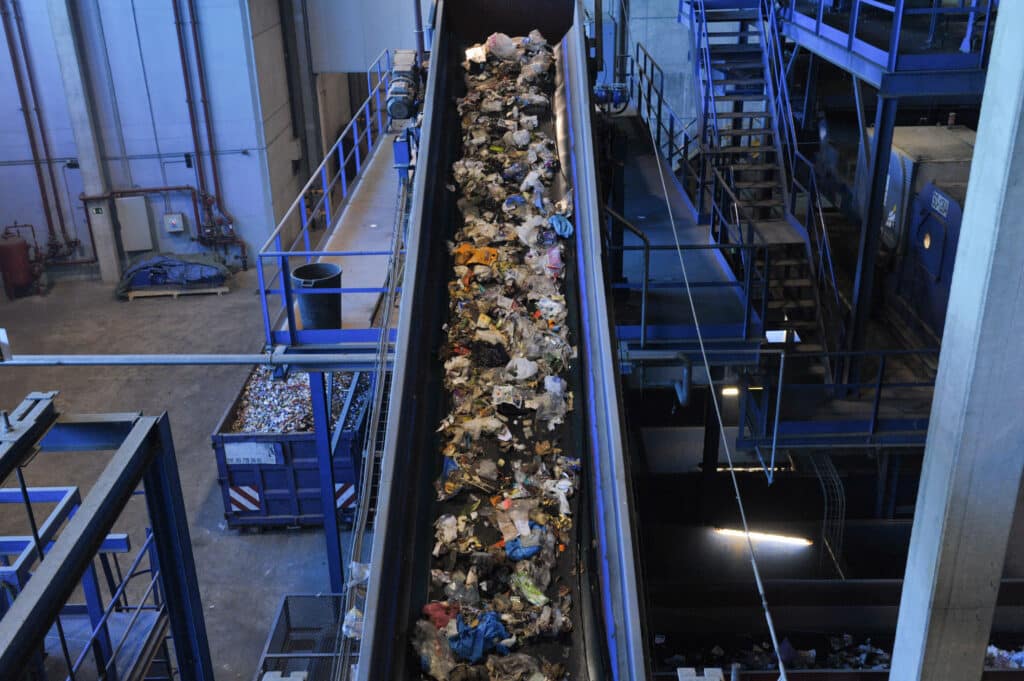
Maresme Integral Centre for Waste Recovery / Marga Cruz
More than 10,903 tonnes of materials recovered for recycling
In the county, waste collected from grey bins is managed at the Maresme Integral Centre for Waste Recovery. In 2023, the Centre treated 117,353 tonnes of residual waste from the Maresme region, from which it was able to recover more than 10,903 tonnes of recyclable material (which should not have been thrown in the grey bin at source).
The waste that cannot be recovered is converted to energy, generating 36,767 MWh of electricity in 2023 from the Maresme residual fraction, which is equivalent to the annual electricity supply of more than 12,255 families.
Compliance with recycling targets
The selective collection data indicate the amount of all waste fractions collected selectively. However, these contain improper waste, and furthermore, losses are produced throughout the management chain, so the final recycling level is below that of selective collection.
In Catalonia it is estimated that in 2023 the recycling rate reached 40.3%, still far from the European targets of 55% recycling by 2025 and 60% by 2030. In the case of the Maresme region, the contribution to the separation of recyclables by the Maresme Integral Centre for Waste Recovery makes it possible to achieve a real recycling rate of 42%.
Waste situation in relation to Catalonia
The average per capita generation of municipal waste in Catalonia in 2023 was 477 kg/inhabitant/year and the percentage of selective collection was 46.7%. In other words, in the Maresme region we generate an average of 15 kg/inhabitant/year more waste than in Catalonia as a whole and we separate it slightly less (0.3 percentage points below the Catalan average).
With regard to the waste that goes to a controlled landfill, Catalonia sends 31.7% of its waste to this end. We can therefore say that the Maresme, which sends just 0.1%, is the leader in the management of the residual waste fraction.
Complete statistics: http://estadistiques.arc.cat/ARC/
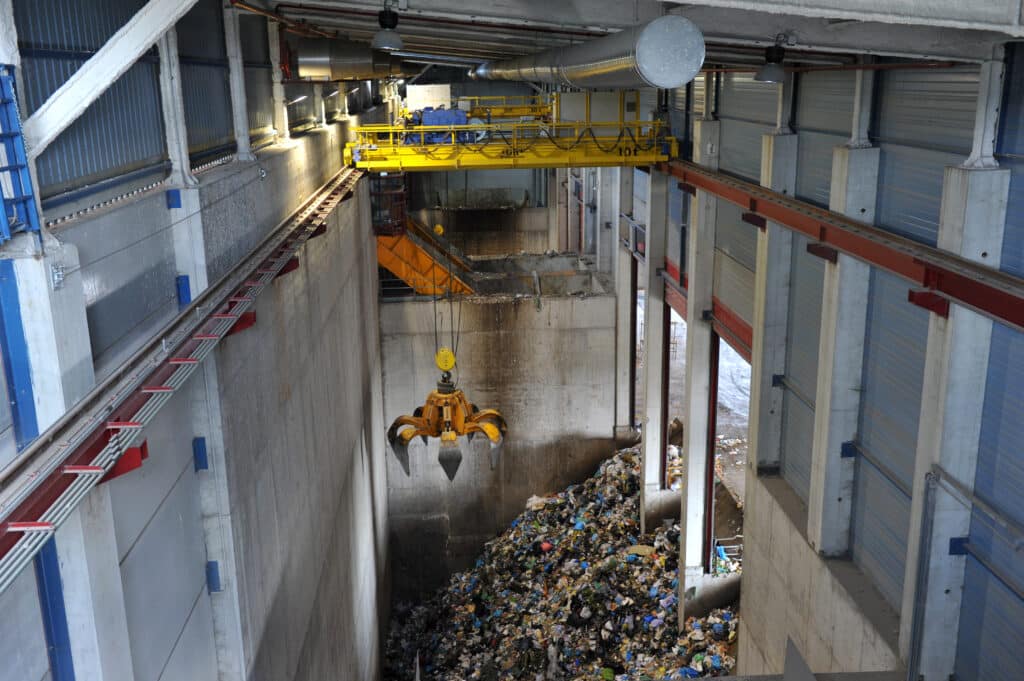
Maresme Integral Centre for Waste Recovery / Marga Cruz




